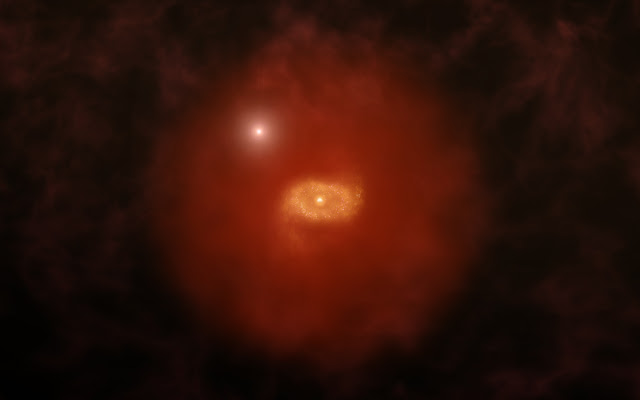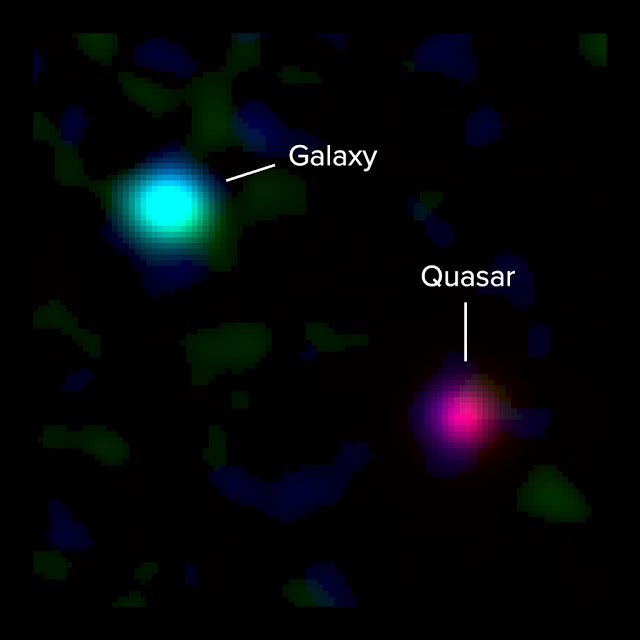

| Online: | |
| Visits: | |
| Stories: |

| Story Views | |
| Now: | |
| Last Hour: | |
| Last 24 Hours: | |
| Total: | |
‘Super Halos’ Enveloped Milky Way-Like Galaxies in Early Universe
Astronomers initially detected these galaxies by studying the intense light from even-more-distant quasars. As this light travels through an intervening galaxy on its way to Earth, it can pick up the unique spectral signature from the galaxy’s gas. This technique, however, normally prevents astronomers from seeing the actual light emitted by the galaxy, which is overwhelmed by the much brighter emission from the background quasar.
With ALMA, the astronomers were finally able to observe the natural millimeter-wavelength “glow” emitted by ionized carbon in the dense and dusty star-forming regions of the galaxies. This carbon signature, however, is considerably offset from the gas first detected by quasar absorption. This extreme separation indicates that the galaxies’ gas content extends well beyond their star-filled disks, suggesting that each galaxy is embedded in a monstrous halo of hydrogen gas.
“We had expected we would see faint emission right on top of the quasar, and instead we saw bright galaxies at large separations from the quasar,” said J. Xavier Prochaska, professor of astronomy and astrophysics at UC Santa Cruz and coauthor of the paper. The separation from the quasar to the observed galaxy is about 137,000 light-years for one galaxy and about 59,000 light-years for the other.
Credit: Produced by Alexandra Angelich (NRAO/AUI/NSF); Written and narrated by Charles Blue (NRAO/AUI/NSF); Animations and footage courtesy of Alexandra Angelich (NRAO/AUI/NSF); NASA/Goddard Space Flight Center/Cruz deWilde and the Advanced Visualization Laboratory at the National Center for Supercomputing and B. O’Shea, M. Norman; ESO/C.Malin; Science images courtesy of M. Neeleman & J. Xavier Prochaska; Keck Observatory; Music by Geodesium
Composite ALMA and optical image of a young Milky Way-like galaxy 12 billion light-years away and a background quasar 12.5 billion light-years away. Light from the quasar passed through the galaxy’s gas on its way to Earth, revealing the presence of the galaxy to astronomers. New ALMA observations of the galaxy’s ionized carbon (green) and dust continuum (blue) emission show that the dusty, star-forming disk of the galaxy is vastly offset from the gas detected by quasar absorption at optical wavelengths (red). This indicates that a massive halo of gas surrounds the galaxy. The optical data are from the Keck I Telescope at the W.M. Keck Observatory.
The new ALMA data show that these young galaxies are already rotating, which is one of the hallmarks of the massive spiral galaxies we see in the universe today. The ALMA observations further reveal that both galaxies are forming stars at moderately high rates: more than 100 solar masses per year in one galaxy and about 25 solar masses per year in the other.
“These galaxies appear to be massive, dusty, and rapidly star-forming systems, with large, extended layers of gas,” Prochaska said.
“ALMA has solved a decades-old question on galaxy formation,” said Chris Carilli, an astronomer with the National Radio Astronomy Observatory in Socorro, N.M., and co-author on the paper. “We now know that at least some very early galaxies have halos that are much more extended that previously considered, which may represent the future material for galaxy growth.”
The galaxies, which are officially designated ALMA J081740.86+135138.2 and ALMA J120110.26+211756.2, are each about 12 billion light-years from Earth. The background quasars are each roughly 12.5 billion light-years from Earth.
The National Radio Astronomy Observatory is a facility of the National Science Foundation, operated under cooperative agreement by Associated Universities, Inc.
Contacts and sources:
Charles Blue
Source:




